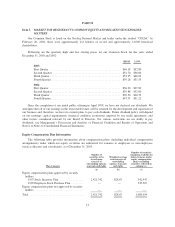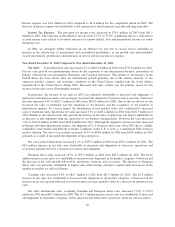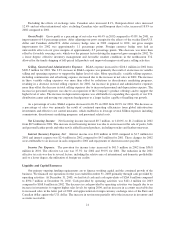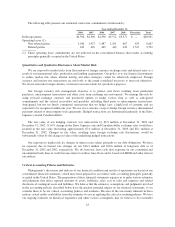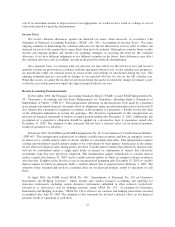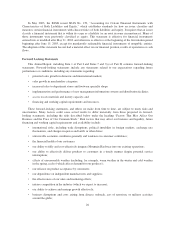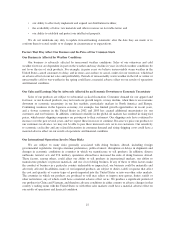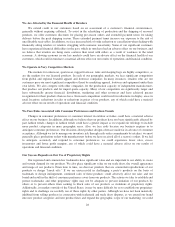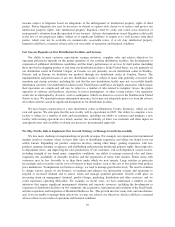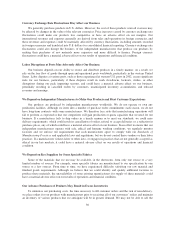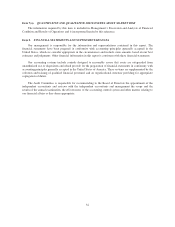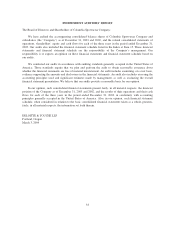Columbia Sportswear 2003 Annual Report Download - page 29
Download and view the complete annual report
Please find page 29 of the 2003 Columbia Sportswear annual report below. You can navigate through the pages in the report by either clicking on the pages listed below, or by using the keyword search tool below to find specific information within the annual report.under the circumstances. Some of these critical accounting policies affect working capital account balances,
including the policy for revenue recognition, the allowance for doubtful accounts receivable, and inventory
obsolescence.
Management and our independent auditors regularly discuss with our audit committee each of our critical
accounting estimates and the development and selection of these accounting estimates and the disclosure about
each estimate in Management’s Discussion and Analysis of Financial Condition and Results of Operations. These
discussions typically occur at our quarterly audit committee meetings and include the basis and methodology
used in developing and selecting these estimates; the trends in and amounts of these estimates; specific matters
affecting the amount of and changes in these estimates, and any other relevant matters related to these estimates,
including significant issues concerning accounting principles and financial statement presentation.
Revenue Recognition
We record wholesale and licensed product revenues when title passes and the risks and rewards of
ownership have passed to the customer, based on the terms of sale. Title generally passes upon shipment or upon
receipt by the customer depending on the country of the sale and the agreement with the customer. Retail store
revenues are recorded at the time of sale.
In some countries outside of the U.S., predominantly where we sell directly in Western Europe, precise
information regarding the date of receipt by the customer is not readily available. In these cases, we estimate the
date of receipt by the customer based on historical and expected delivery times by geographic location. We
periodically test the accuracy of these estimates based on actual transactions. Delivery times vary by geographic
location, generally from one to four days. To date, we have found these estimates to be materially accurate.
Upon shipment, we also provide for estimated sales returns and miscellaneous claims from customers as
reductions to revenues. The estimates are based on historical rates of product returns and claims that have ranged
from approximately one to two percent of sales. However, actual returns and claims in any future period are
inherently uncertain and thus may differ from the estimates. If actual or expected future returns and claims were
significantly greater or lower than the reserves that had been established, we would record a reduction or increase
to net revenues in the period in which we made such a determination.
Allowance for Uncollectible Accounts Receivable
We make ongoing estimates for the uncollectibility of our accounts receivable and maintain an allowance
for estimated losses resulting from the inability of our customers to make required payments. In determining the
amount of the allowance, we consider our historical level of credit losses and we make judgments about the
credit worthiness of customers based on ongoing credit evaluations. We analyze specific customer accounts,
customer concentrations, current economic trends, and changes in customer payment terms. Because we cannot
predict future changes in the financial stability of our customers, actual future losses from uncollectible accounts
may differ from our estimates. If the financial condition of our customers were to deteriorate, resulting in their
inability to make payments, a larger allowance could be required. If we determine a smaller or larger allowance
is appropriate, we would record a credit or a charge to SG&A expense in the period in which we made the
determination.
Inventory Obsolescence and Product Warranty
We make ongoing estimates of potential future excess, close-out or slow moving inventory and product
warranty costs. We identify our excess inventory, a component of which is planned, and evaluate our purchase
commitments, sales forecasts, and historical experience and make provisions as necessary to properly reflect
inventory value. When evaluating our reserve for warranty costs, we consider our historical returns rates by
season, product mix, current economic trends, and the historical cost to repair, replace, or refund the original
24


